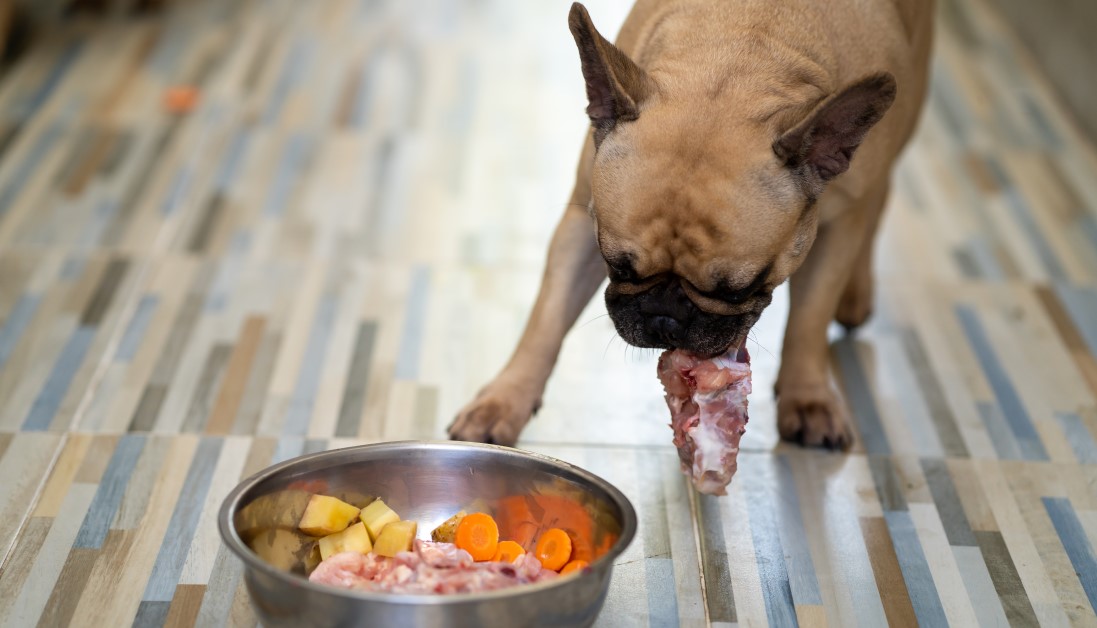Homemade Pet Food: Benefits, Risks, and Essential Nutrients
Homemade pet food can provide many key advantages but it’s important to weigh these health benefits with potential risks.

For decades, pet owners relied on manufacturers to provide dogs and cats with the nutrition they needed to thrive, often purchasing dry kibble or canned wet food. While these off-the-shelf products do contain essential vitamins and minerals, research shows that they may lack the balanced diet pets need for long-term health and wellness.
Findings from a study published in the Journal of American Veterinary Medical Association revealed that very few of the 200 pet food recipes analyzed by researchers provided all of the key nutrients in adequate amounts necessary to meet canine health standards.
To give our pets the best nutrition possible, many turn to homemade pet food. Preparing homemade pet food comes with both risks and rewards. It’s important to carefully evaluate your pet’s unique dietary needs to determine if this option is best suited for your cat or dog.
Let’s look at the pros and cons of homemade pet food.
Benefits of Preparing Homemade Pet Food
The biggest reason so many pet owners make the switch to homemade alternatives is to know exactly what’s going into their pet’s food. They have real concerns about filler or processed ingredients, non-organic additives, and GMOs that could be causing harm. Tolerance may also be a factor. Some dogs and cats have sensitive stomachs or may be overly picky, making homemade pet food the only option.
Preparing food at home for your pet means you’re in control of the ingredients. Unlike commercial foods, which often contain preservatives, fillers, and additives, homemade alternatives allow you to choose high-quality, fresh ingredients that you obtain yourself from trusted sources. This allows you to meet your pet’s unique nutritional needs while avoiding potential allergy triggers or food sensitivities.
Nutritional quality is also improved with homemade meals. When making dog food or cat food yourself, you can incorporate everything your animals need to live well, such as proteins, fruits, vegetables, and carbohydrates. You can also avoid the processed ingredients that could contribute to excess weight gain or health problems, helping your pet live a healthier and longer life.
Don’t overlook the importance of digestion. Commercial pet foods often contain ingredients that can lead to gastrointestinal problems, such as vomiting, diarrhea, and gas. Preparing meals made from natural and fresh ingredients can often reduce the risk of gastrointestinal upset, as the ingredients are usually easier for pets to digest and promote better nutrient absorption.
Risks of Serving Homemade Pet Food to Dogs and Cats
Deciding to switch to homemade pet food for your animals also comes with certain risks. One of the biggest challenges involved in this process is making sure that the meals you make are nutritionally balanced. Missing essential vitamins and minerals could be detrimental to your pet’s health, leading to potential illnesses, weakened immune system, and possible disease.
Pets require a precise balance of fats, vitamins, minerals, carbohydrates, and proteins to maintain good health. Sourcing high-quality ingredients that have high nutritional value can help your cat or dog remain healthy and active. However, homemade pet food can lack essential nutrients when pet owners don’t take the time to plan a balanced diet and consult professionals like veterinarians and veterinary nutritionists.
Also, consider the time commitment involved in preparing these meals. Homemade pet food preparation can be a major time commitment, compared to ready-to-serve commercial foods. Busy pet owners may not have the time needed to carefully plan meals, source and prep ingredients, and cook the foods necessary to give their pets a balanced diet.
Finally, consider the cost. Although homemade meals may seem like a more cost-effective option compared to commercial options, they can actually be more expensive. High-quality ingredients, along with extras like supplements and specialized equipment, can make preparing homemade pet food a very expensive endeavor in the long term. The veterinary consultations involved in the process can also exceed your desired budget.
Tips on Preparing Homemade Dog Food or Cat Food
When planning a diet for your cat or dog, it’s essential to consider what nutrients they’ll need to maintain optimal health.
High-quality protein is a must to maintain lean muscle mass. Opt for high-quality protein sources like poultry, fish, and lean meats. Next, consider the amount of fat in your pet’s diet. Avoid excessive dietary fats, as these can contribute to obesity. Instead, introduce moderate amounts of healthy fats, such as those found in flaxseed and fish.
Another nutrient to consider when preparing a homemade pet diet is carbohydrates. Choose complex carbohydrates that offer a steady source of energy. Sweet potatoes, quinoa, brown rice, and other whole grains can be excellent choices. Also, add omega-3 fatty acids to meals as they can provide anti-inflammatory benefits. Omega-3 fatty acids can be found in a variety of foods, as well as fish oil supplements.
Keeping Your Pet Healthy with a Balanced Diet
Whether you choose a homemade diet or prefer the convenience of commercial pet food, always take the time to review the ingredients and fill potential nutritional gaps. Consult with your vet about any concerns you may have about your pet’s diet or for further advice.
Ready to start saving money on pet wellness care?
Then take a look at Mint Wellness, the pet wellness plan that provides fast reimbursement on routine pet care. Save on vaccinations, wellness exams, preventatives, dental, and more!
Learn More
